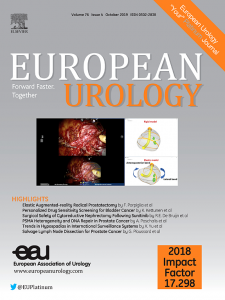Magnetic Resonance Imaging–led Risk-adapted Active Surveillance for Prostate Cancer: Updated Results from a Large Cohort Study
IF 25.3
1区 医学
Q1 UROLOGY & NEPHROLOGY
引用次数: 0
Abstract
Background and objective
Magnetic resonance imaging (MRI)-led active surveillance (AS) for prostate cancer uses prostate-specific antigen (PSA) and MRI for regular monitoring with biopsy only when indicated by changes in MRI or PSA density.Methods
This clinical cohort, which started AS between February 2000 and July 2023, includes those with (1) Gleason score (GS) ≤3 + 4, (2) PSA <20 ng/ml, and (3) at least two MRI scans. The primary outcome was event-free survival (EFS) defined as histological upgrade to GS ≥4 + 3 or transition to treatment. Patients were risk stratified by baseline MRI visibility and Gleason pattern 4, and Kaplan-Meier curves were used to compare groups.Key findings and limitations
The cohort consisted of 1150 patients with a median follow-up of 64 mo per person overall (quartiles: 32, 107). At baseline, of these 1150 patients, 412 (36%) had GS 3 + 4, 627 (55%) had an MRI-visible lesion, and 201 (17%) had MRI-visible Gleason 3 + 4 disease. The EFS rate at 5 yr was 91% (95% confidence interval: 88–94%) for nonvisible GS 3 + 3, 71% (65–78%) for MRI-visible GS 3 + 3, 70% (63–78%) for nonvisible GS 3 + 4, and 44% (35–54%) for MRI-visible GS 3 + 4. A total of 487 patients had follow-up biopsies, with 74 having more than one, and histological upgrade to GS ≥4 + 3 was uncommon, occurring in 67 patients. Progression to nodal or bone metastases occurred in ten patients and only in those who had declined the recommended follow-up MRI and/or biopsies. Thirty patients chose treatment despite having stable characteristics, and 31 were lost to follow-up.Conclusions and clinical implications
MRI visibility and secondary Gleason pattern 4 at baseline are associated with progression to treatment and to primary Gleason pattern 4 during MRI-led AS.磁共振成像引导的前列腺癌风险适应主动监测:一项大型队列研究的最新结果
背景和目的磁共振成像(MRI)主导的前列腺癌主动监测(AS)仅在MRI或PSA密度变化指示时使用前列腺特异性抗原(PSA)和MRI进行定期活检监测。该临床队列研究于2000年2月至2023年7月期间开始,包括(1)Gleason评分(GS)≤3 + 4,(2)PSA≤20ng /ml,(3)至少两次MRI扫描的患者。主要终点是无事件生存期(EFS),定义为组织学升级到GS≥4 + 3或过渡到治疗。根据基线MRI可见性和Gleason模式4对患者进行风险分层,并使用Kaplan-Meier曲线进行组间比较。主要发现和局限性该队列包括1150例患者,平均每人随访64个月(四分位数:32,107)。基线时,在这1150例患者中,412例(36%)为GS 3 + 4, 627例(55%)为mri可见病变,201例(17%)为mri可见Gleason 3 + 4。不可见GS 3 + 35年的EFS率为91%(95%可信区间:88-94%),mri可见GS 3 + 3为71% (65-78%),mri可见GS 3 + 4为70% (63-78%),mri可见GS 3 + 4为44%(35-54%)。487例患者进行了随访活检,74例患者不止一次活检,组织学升级到GS≥4 + 3的情况不常见,67例患者。10例患者进展为淋巴结或骨转移,仅发生在那些拒绝推荐的后续MRI和/或活检的患者中。30例患者在特征稳定的情况下仍选择治疗,31例失访。结论和临床意义在mri引导的AS期间,smri可视性和基线时继发性Gleason 4型与治疗进展和原发性Gleason 4型相关。
本文章由计算机程序翻译,如有差异,请以英文原文为准。
求助全文
约1分钟内获得全文
求助全文
来源期刊

European urology
医学-泌尿学与肾脏学
CiteScore
43.00
自引率
2.60%
发文量
1753
审稿时长
23 days
期刊介绍:
European Urology is a peer-reviewed journal that publishes original articles and reviews on a broad spectrum of urological issues. Covering topics such as oncology, impotence, infertility, pediatrics, lithiasis and endourology, the journal also highlights recent advances in techniques, instrumentation, surgery, and pediatric urology. This comprehensive approach provides readers with an in-depth guide to international developments in urology.
 求助内容:
求助内容: 应助结果提醒方式:
应助结果提醒方式:


